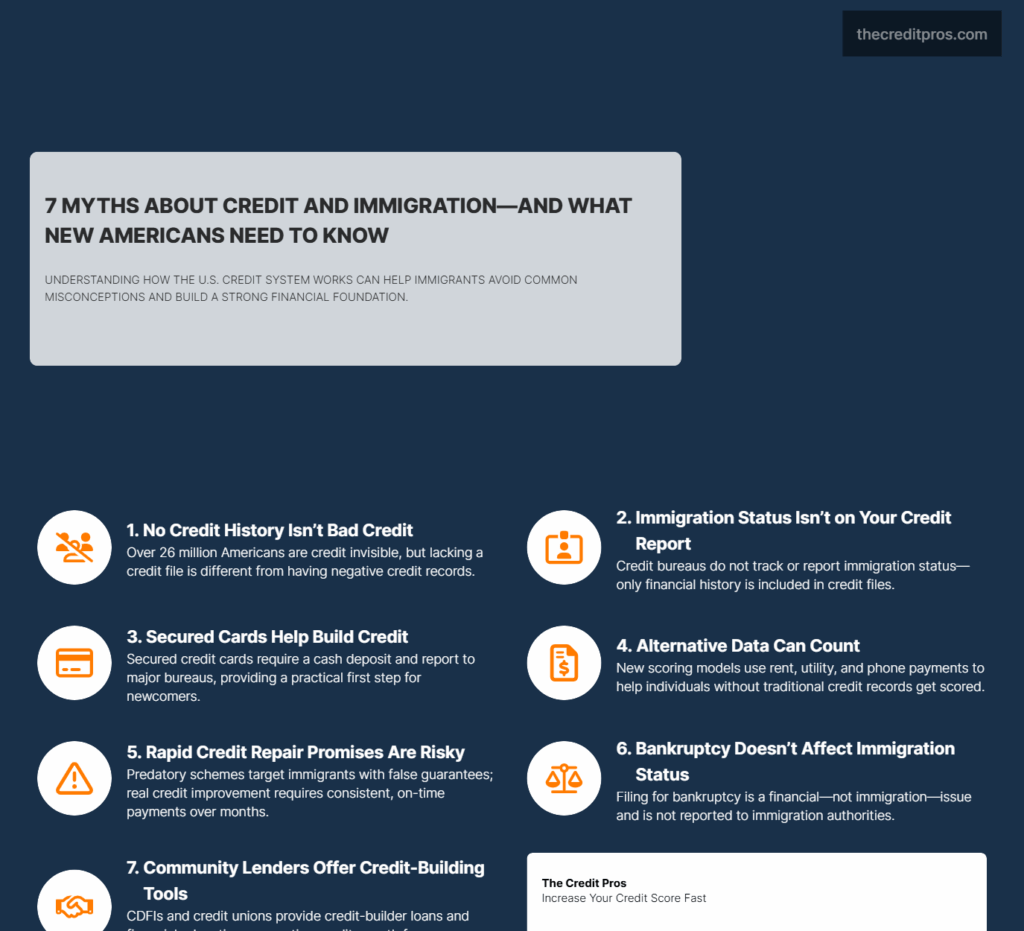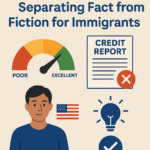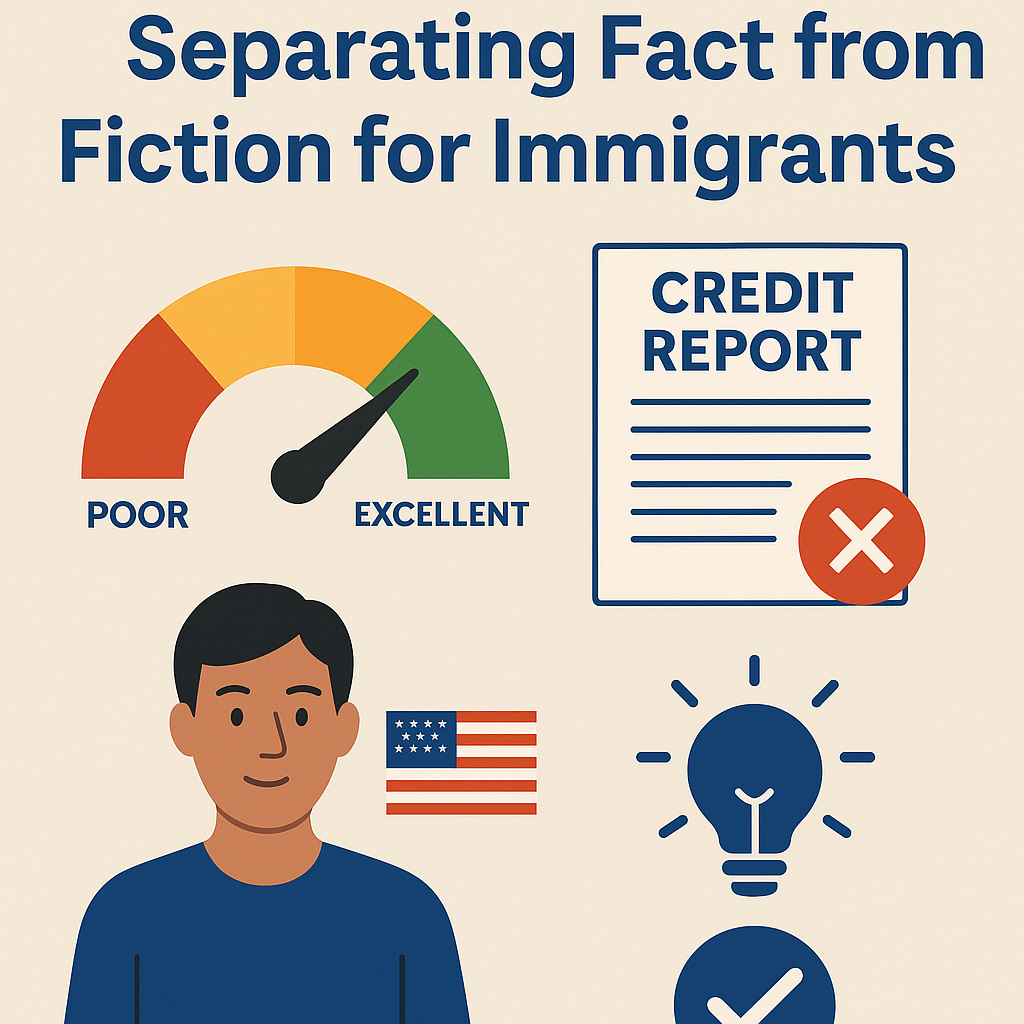When you’re new to the U.S. credit system, the advice you receive can feel overwhelming and often contradictory. You might hear that having no credit history automatically makes you a risky borrower, or that your immigration status directly affects your credit score calculations. These widespread misconceptions create unnecessary barriers and anxiety for millions of immigrants who are simply trying to build financial stability in their new home country. Understanding credit score myths for immigrants is crucial to navigating financial systems effectively.

Understanding the truth behind credit score myths for immigrants can greatly aid in their credit journey. The truth is, much of what circulates about credit scores and immigration contains outdated information or outright myths that can lead you down expensive dead ends. Understanding the real mechanics behind credit scoring—and knowing which factors actually matter versus which ones don’t—can save you both time and money while helping you build a solid financial foundation. What if the very challenges you think are holding you back aren’t actually obstacles at all? Recognizing common credit score myths for immigrants helps in making informed financial choices.
The “No Credit History Equals Bad Credit” Fallacy
As we tackle credit score myths for immigrants, we create pathways for financial literacy and empowerment. Credit invisibility affects approximately 26 million Americans, with immigrants representing a substantial portion of this population. This widespread condition occurs when individuals lack sufficient credit information in their files for credit scoring models to generate a score, creating a distinct category separate from those with poor credit histories. The fundamental difference lies in the absence of data versus the presence of negative data, though both situations present challenges for accessing traditional financial products.
Lenders approach these two scenarios with markedly different risk assessment strategies. Borrowers with no credit history represent an unknown quantity, while those with poor credit demonstrate a documented pattern of financial difficulty. Financial institutions often develop specialized products for credit-invisible consumers, recognizing that this population includes responsible individuals who simply haven’t participated in the traditional credit system. The distinction becomes crucial when immigrants seek their first credit cards, auto loans, or mortgages in the United States. Many credit score myths for immigrants can lead to significant misunderstandings about how the system works.
The paradox of needing credit to build credit creates a circular challenge that particularly impacts immigrant communities. Traditional credit scoring models rely heavily on payment history and credit age, factors that recent immigrants cannot immediately establish. However, several strategic workarounds exist specifically designed to address this challenge. Secured credit cards require a cash deposit that serves as collateral, effectively eliminating risk for lenders while providing credit-building opportunities for consumers. These products report to major credit bureaus, allowing users to establish payment history and credit utilization patterns that form the foundation of credit scores. It’s essential to identify and debunk credit score myths for immigrants to empower them in financial decisions.
Alternative credit scoring models have emerged to address the limitations of traditional FICO scoring for credit-invisible populations. FICO XD and VantageScore 4.0 incorporate non-traditional data sources, including utility payments, telecommunications bills, and banking transaction patterns. These models can generate scores for individuals who lack traditional credit accounts, providing lenders with risk assessment tools for previously unscoreable applicants. The integration of alternative data represents a significant shift in credit evaluation, particularly benefiting immigrants who maintain consistent financial behaviors outside traditional credit products. By understanding credit score myths for immigrants, borrowers can better navigate lender expectations.
Authorized user status offers another strategic pathway for credit establishment without requiring independent credit qualification. When added as an authorized user to an existing account holder’s credit card, the account’s payment history and credit utilization typically appear on the authorized user’s credit report. This arrangement allows immigrants to benefit from another person’s positive credit management while beginning to establish their own credit profiles. The strategy requires careful selection of the primary account holder, as negative account activity also transfers to authorized users. Many individuals fall prey to credit score myths for immigrants, believing their status directly impacts their creditworthiness.
Understanding Credit Score Impact on Immigration Status
Credit bureaus operate independently from immigration authorities and do not collect, track, or report immigration status information. The three major credit reporting agencies—Experian, Equifax, and TransUnion—focus exclusively on financial behavior data provided by creditors, landlords, and other financial institutions. This separation means that credit scores themselves contain no information about visa status, green card applications, or citizenship documentation, contrary to widespread misconceptions within immigrant communities. For immigrants, dispelling credit score myths for immigrants can enhance their understanding of the system.
The confusion between immigration processes and credit history stems from specific circumstances where financial stability demonstrations intersect with immigration requirements. Public charge considerations, historically used to evaluate whether immigrants might require government assistance, have occasionally involved credit report reviews as evidence of financial responsibility. However, these evaluations focus on debt management and income stability rather than credit scores themselves. The distinction proves crucial for understanding when and how credit information might appear in immigration contexts. Comprehending credit score myths for immigrants is essential for long-term financial success.
Employment-based visa applications in sensitive sectors may involve comprehensive background checks that include financial history reviews. Government positions, financial services roles, and security clearance requirements can trigger credit report examinations as part of broader suitability assessments. Facing credit score myths for immigrants head-on can lead to better financial literacy. These reviews evaluate financial responsibility and potential security risks rather than creditworthiness for lending purposes. The process differs significantly from consumer credit applications and serves distinct evaluation purposes within employment and security frameworks.
Immigration status fears often prevent individuals from engaging with credit systems, creating unnecessarily prolonged periods of credit invisibility. Credit inquiries from legitimate financial institutions do not generate reports to immigration authorities, nor do they create government tracking mechanisms. The credit system operates within consumer financial protection frameworks that maintain strict privacy and data use limitations. Understanding these boundaries helps immigrants make informed decisions about credit participation without unfounded concerns about immigration consequences. Being aware of credit score myths for immigrants can vastly improve their approach to credit management.
Financial background checks in immigration contexts typically focus on income stability, debt management, and overall financial responsibility rather than specific credit scores. Sponsorship requirements for family-based immigration examine sponsors’ ability to provide financial support, evaluating income levels and existing obligations. These assessments may include credit reports to verify debt loads and payment patterns, but the evaluation criteria differ substantially from lending decisions. Identifying the truth behind credit score myths for immigrants is fundamental for effective credit building. The emphasis falls on financial capacity and stability rather than creditworthiness optimization.
Debunking Rapid Credit Repair Myths
Credit score calculations involve complex algorithms that weight multiple factors over extended time periods, making rapid improvements mathematically impossible through legitimate means. Payment history accounts for 35% of FICO scores, requiring consistent on-time payments over months to demonstrate reliability. Credit utilization ratios, representing 30% of score calculations, can improve within billing cycles but require sustained management for lasting impact. The remaining factors—credit history length, credit mix, and new credit inquiries—inherently require time to develop and optimize. Credit score myths for immigrants often deter them from seeking necessary financial assistance.
Legitimate credit building follows predictable timelines based on specific financial behaviors and their reporting cycles. Secured credit cards typically begin reporting to bureaus within 30-60 days of account opening, with initial score generation possible after three to six months of payment history. Authorized user additions can appear on credit reports within one to two billing cycles, potentially providing faster initial score establishment. However, meaningful score improvements generally require consistent positive behavior over six-month periods minimum. Engaging with the reality of credit score myths for immigrants promotes healthier financial habits.
Credit utilization changes offer the most immediate potential for score improvement, with updates typically reflecting within 30-45 days of payment processing. Reducing credit card balances below 30% of available limits can generate noticeable score increases, while maintaining utilization below 10% often produces optimal results. However, these improvements require sustained low balances rather than temporary reductions, as utilization reporting reflects statement closing dates rather than payment due dates. It’s vital to separate reality from credit score myths for immigrants to prevent misinformation.

Predatory credit repair schemes specifically target immigrant communities with promises of rapid score improvements and guaranteed results. These operations frequently charge upfront fees for services that consumers can perform independently, including disputing inaccurate information and negotiating payment plans. Legitimate credit repair involves systematic review of credit reports, dispute filing for errors, and strategic debt management—processes that require time and cannot be accelerated through payment of fees. Many immigrants experience challenges due to pervasive credit score myths for immigrants that distort reality.
The compounding effect of consistent financial behaviors becomes apparent over three to six month periods, with more substantial improvements visible after 12-18 months of positive credit management. Each on-time payment strengthens payment history, while maintained low utilization ratios demonstrate ongoing financial discipline. Credit mix diversification through different account types can enhance scores over time, though this strategy requires careful financial planning to avoid overextension. The mathematical reality of credit scoring rewards sustained positive behavior rather than quick fixes or dramatic interventions. Awareness of credit score myths for immigrants is a step towards informed financial decision-making.
How Debt and Bankruptcy Affect Immigration Applications
Bankruptcy filing creates no direct connection to immigration status or proceedings, operating entirely within financial and legal frameworks separate from immigration law. Chapter 7 and Chapter 13 bankruptcy proceedings focus on debt resolution and creditor protection, with no reporting requirements to immigration authorities. The misconception that bankruptcy affects immigration status likely stems from broader concerns about financial responsibility demonstrations in specific immigration contexts, rather than actual legal connections between bankruptcy courts and immigration processes. Breaking down credit score myths for immigrants can lead to more significant opportunities in financial markets.
Chapter 7 bankruptcy typically remains on credit reports for ten years but allows for credit rebuilding immediately following discharge. The process eliminates most unsecured debts, providing a clean financial slate that can facilitate faster credit recovery compared to prolonged debt struggles. Credit scores often begin improving within 12-18 months post-discharge as the debt-to-income ratio improves and new positive payment history accumulates. This timeline contrasts sharply with Chapter 13 bankruptcy, which involves structured payment plans over three to five years but may allow retention of assets like homes and vehicles. Combatting credit score myths for immigrants aids in paving the way for better financial futures.
Managed debt differs significantly from unmanaged financial obligations in both credit impact and immigration considerations. Structured payment plans, debt consolidation, and credit counseling demonstrate financial responsibility and commitment to obligation fulfillment. These approaches typically result in less severe credit score impacts compared to defaults, charge-offs, or collections. Documentation of debt management efforts can serve as evidence of financial responsibility in contexts where such demonstrations prove necessary. Awareness of credit score myths for immigrants can empower individuals to take charge of their financial destinies.
Debt settlement consequences affect credit scores through account closures and potential tax implications but create no immigration law violations or reporting requirements. Settled accounts typically appear as “settled for less than full balance” on credit reports, impacting scores for up to seven years. However, the credit impact diminishes over time, particularly when followed by consistent positive financial behavior. The process remains entirely within consumer financial frameworks without immigration system intersections. Addressing credit score myths for immigrants ultimately fosters a more inclusive financial landscape.
Financial counseling and structured payment plans provide documented evidence of proactive financial management during challenging periods. Non-profit credit counseling agencies offer debt management plans that can reduce interest rates and establish systematic payment schedules. These arrangements demonstrate financial responsibility and commitment to obligation fulfillment, qualities that may prove valuable in contexts requiring financial stability demonstrations. The documentation from legitimate counseling agencies provides third-party verification of financial rehabilitation efforts. As we address credit score myths for immigrants, we contribute to a more equitable financial environment.
Alternative Credit Building Strategies for Immigrants
Community Development Financial Institutions (CDFIs) offer credit-builder loans specifically designed for individuals lacking traditional credit histories. These specialized products require borrowers to make regular payments into savings accounts, with loan proceeds held as collateral until payment completion. The arrangement creates positive payment history while building savings, addressing both credit establishment and emergency fund development simultaneously. CDFIs often serve immigrant communities and understand the unique challenges faced by individuals new to the U.S. financial system. Ultimately, dismantling credit score myths for immigrants is essential to their economic empowerment.
Rent reporting services convert existing housing payments into credit-building activities by reporting monthly rent payments to credit bureaus. Services like RentTrack, PayYourRent, and Rental Kharma allow tenants to establish payment history through housing expenses they already manage. This approach particularly benefits immigrants who demonstrate financial responsibility through consistent rent payments but lack traditional credit accounts. The strategy requires verification of rental payment history and ongoing reporting service fees. Shared understanding of credit score myths for immigrants can drive community support and development.
Alternative credit scoring models increasingly incorporate utility and telecommunications payment data, recognizing these expenses as indicators of financial responsibility. Experian Boost allows consumers to add utility, phone, and streaming service payments to their credit files, potentially improving scores through previously uncounted positive payment history. VantageScore 4.0 naturally incorporates telecommunications and utility data when available, providing scoring opportunities for consumers with limited traditional credit exposure.
Credit mix optimization involves strategic diversification of account types to demonstrate experience with different credit products. The category includes revolving credit (credit cards), installment loans (auto loans, personal loans), and mortgage debt, with optimal scores typically reflecting experience across multiple categories. However, pursuing credit mix improvement requires careful financial planning to avoid overextension or unnecessary debt accumulation. The strategy works best when aligned with legitimate financial needs rather than score optimization alone.
Strategic Credit Building Approaches for Immigrants:
- Secured credit cards with graduation pathways to unsecured products
- Credit-builder loans from community banks and credit unions
- Authorized user arrangements with trusted family members or friends
- Rent reporting services to monetize existing housing payments
- Utility and phone bill reporting through credit monitoring services
- Alternative credit scoring program participation (Experian Boost, UltraFICO)
The role of community banks and credit unions in serving immigrant populations extends beyond traditional products to include financial education and culturally sensitive services. These institutions often maintain more flexible underwriting standards and greater willingness to work with customers lacking extensive credit histories. Many offer specialized programs for new Americans, including secured credit products with lower fees and educational components designed to explain U.S. credit systems. The relationship-based approach of smaller financial institutions can provide advantages for immigrants seeking to establish credit while building long-term banking relationships.
Breaking Down Barriers: The Path Forward
Knowledge of credit score myths for immigrants is a powerful tool for community growth and stability. The myths surrounding credit scores and immigration status create unnecessary obstacles that prevent millions of immigrants from accessing the financial tools they need to build stable lives in America. Your immigration status doesn’t appear on credit reports, having no credit history isn’t the same as having bad credit, and rapid credit repair schemes that target immigrant communities are largely predatory. The real path forward involves understanding legitimate credit-building strategies like secured credit cards, authorized user arrangements, and alternative scoring models that recognize non-traditional payment histories, all while debunking credit score myths for immigrants. Enhancing awareness of credit score myths for immigrants encourages more responsible financial behaviors.

These misconceptions aren’t just harmless confusion—they’re barriers that keep hardworking individuals from participating in the financial systems that could improve their lives. By separating fact from fiction, you can make informed decisions about credit building without the fear and anxiety that myths create. The U.S. credit system, while complex, offers multiple pathways for establishing creditworthiness that don’t require you to navigate expensive shortcuts or worry about immigration consequences. The question isn’t whether you can build credit as an immigrant—it’s whether you’ll let outdated myths continue to hold you back from the financial stability you’re working so hard to achieve. Investing in education around credit score myths for immigrants can transform their financial futures.


